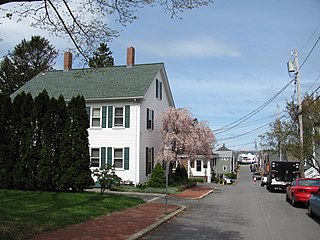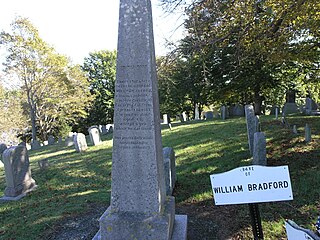
Plymouth is a town and county seat of Plymouth County, Massachusetts, United States. Located in Greater Boston, the town holds a place of great prominence in American history, folklore, and culture, and is known as "America's Hometown". Plymouth was the site of the colony founded in 1620 by the Mayflower Pilgrims, where New England was first established. It is the oldest municipality in New England and one of the oldest in the United States. The town has served as the location of several prominent events, one of the more notable being the First Thanksgiving feast. Plymouth served as the capital of Plymouth Colony from its founding in 1620 until the colony's merger with the Massachusetts Bay Colony in 1691. The English explorer John Smith named the area Plymouth and the region 'New England' during his voyage of 1614. It was a later coincidence that, after an aborted attempt to make the 1620 trans-Atlantic crossing from Southampton, the Mayflower finally set sail for America from Plymouth, England.
John Howland was an English indentured servant who accompanied the English Separatists and other passengers when they left England on the Mayflower to settle in Plymouth Colony. In later years, he was an executive assistant and personal secretary to Governor John Carver.

The Pilgrim Hall Museum at 75 Court Street in Plymouth, Massachusetts is the oldest public museum in the United States in continuous operation, having opened in 1824.

Cole's Hill is a National Historic Landmark containing the first cemetery used by the Mayflower Pilgrims in Plymouth, Massachusetts in 1620. The hill is located on Carver Street near the foot of Leyden Street and across the street from Plymouth Rock. Owned since 1820 by the preservationist Pilgrim Society, it is now a public park.

The Richard Sparrow House is a historic house at 42 Summer Street in Plymouth, Massachusetts and the oldest surviving house in Plymouth.

The Harlow Old Fort House is a First Period historic house at 119 Sandwich Street in Plymouth, Massachusetts.

The Bradford–Union Street Historic District encompasses a waterfront residential area of Plymouth, Massachusetts, developed in the mid-19th for workers in local maritime and other industries. It is centered at the junction of Bradford and Union Streets, across Town Brook from downtown Plymouth. The district was added to the National Register of Historic Places in 1983.

The Jabez Howland House is a historic house at 33 Sandwich Street in Plymouth, Massachusetts.

The Town Brook Historic and Archeological District is a historic district encompassing much of the length of Town Brook and its surrounding landscape in Plymouth, Massachusetts. This area has an industrial history that extends to 1620, when the Pilgrims arrived on the Mayflower and established Plymouth Colony. It extends roughly from the crossing of Billington Street, to the mouth of the brook in Plymouth Harbor. The district was listed on the National Register of Historic Places in 1995.

The New Bedford Fire Museum is a local history museum at 51 Bedford Street in New Bedford, Massachusetts, United States. It is located in the 1867 Fire Station No. 4, the city's oldest surviving fire station. The building was listed on the National Register of Historic Places in 1975. The museum is open between July 4 and Labor Day. It houses a collection of firefighting equipment and memorabilia related to the history of firefighting in the city.

The Old Town Historic District is a historic district in North Attleborough, Massachusetts, which encompasses the historic early town center of Attleboro, which it was originally a part of. It was here that Attleboro's first church was built, and its militia training ground was laid out. The district retains 18th-century vestiges of this early history, and was largely bypassed by 19th-century industrialization. The district was added to the National Register of Historic Places in 1991.

The Upper Main Street Historic District is a predominantly residential historic district in northeastern Hatfield, Massachusetts. Unlike Hatfield Center, which dated to colonial days and lies south of the district, this part of Hatfield developed roughly between 1860 and 1939 as a village centered on the nearby ferry landing on the Connecticut River. The district includes properties in a roughly triangular area bounded by Main Street, King Street, and North Street, and features a large number of Colonial Revival, Queen Anne, and bungalow-style houses. The district was listed on the National Register of Historic Places in 1994.

The Rocks Village Historic District is a historic district in eastern Haverhill, Massachusetts. It encompasses a dense community of 25 mainly residential structures at the western end of the Rocks Village Bridge, an early crossing point of the Merrimack River, of which 15 date to the 18th century. The village is significant for its association with the poet John Greenleaf Whittier, who was born nearby, and for the artwork of Rufus Porter, found in one of the houses. The area was designated a local historic district in 1975, and was added to the National Register of Historic Places in 1976.

Burial Hill is a historic cemetery or burying ground on School Street in Plymouth, Massachusetts. Established in the 17th century, it is the burial site of several Pilgrims, the founding settlers of Plymouth Colony. It was listed on the National Register of Historic Places in 2013.

First Parish Church in Plymouth is a historic Unitarian Universalist church at the base of Burial Hill on the town square off Leyden Street in Plymouth, Massachusetts. The congregation was founded in 1620 by the Pilgrims in Plymouth. The current building was constructed in 1899.

The East Plymouth Historic District is a historic district in the town of Plymouth, Connecticut, United States. It encompasses a small rural village in the northeastern part of the town, whose main focus is the 1792 St. Matthew's Church, one of the oldest surviving Episcopal church buildings in the state. The district runs along East Plymouth Road on either side of its junction with Marsh Road, and includes predominantly Greek Revival residential buildings erected in the early to mid-19th century. The district was listed on the National Register of Historic Places in 1985.

The Town Center Historic District encompasses the historic village center of South Hampton, New Hampshire. Centered around the Barnard Green, the town common, on New Hampshire Route 107A, it includes architectural reminders of the town's growth and change over time. The district was listed on the National Register of Historic Places in 1983.

The Mechanicsville Historic District encompasses a cluster of residential properties that are all that remain of one of the early industrial areas of Grafton, Vermont. Located a short way east of Grafton Village on Vermont Route 121, it includes ten well-preserved 19th-century properties, some located on properties where early mills once stood. The district was listed on the National Register of Historic Places in 2010.
The Riverside Village Historic District encompasses a village community near Massachusetts Route 2 in Gill, Massachusetts. The district was listed on the National Register of Historic Places in 1992.

Samuel Lucius–Thomas Howland House is a historic house at 36 North Street in Plymouth, Massachusetts located within the Plymouth Village Historic District, as a contributing property. The house is located adjacent to Cole's Hill from which it is separated by North Street. The earliest part of the house is estimated to be constructed circa 1637–1640, which would make it one of the oldest houses in Massachusetts if accurate. In 1697 Thomas Howland transferred the property to Samuel Lucas. The Jackson and Russell families occupied the property in the nineteenth and early twentieth centuries until 1939. As of 2019, the house remains a private residence.





















